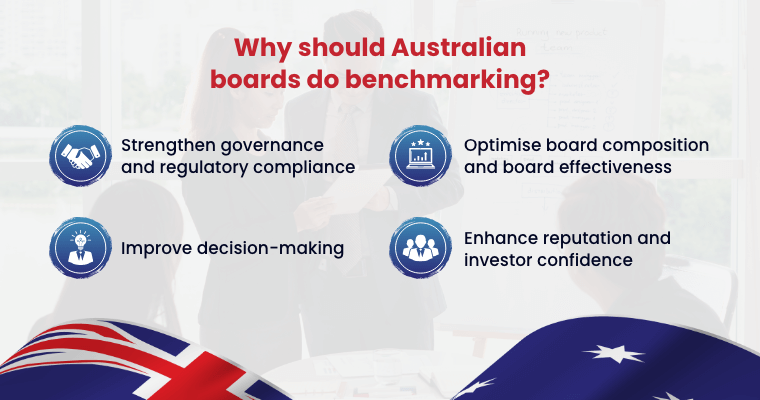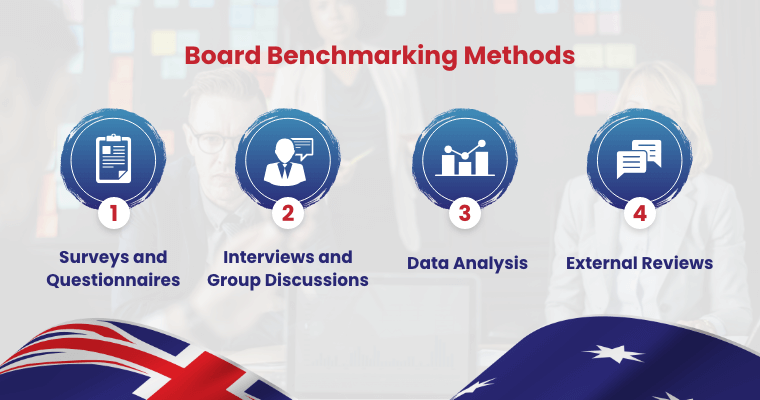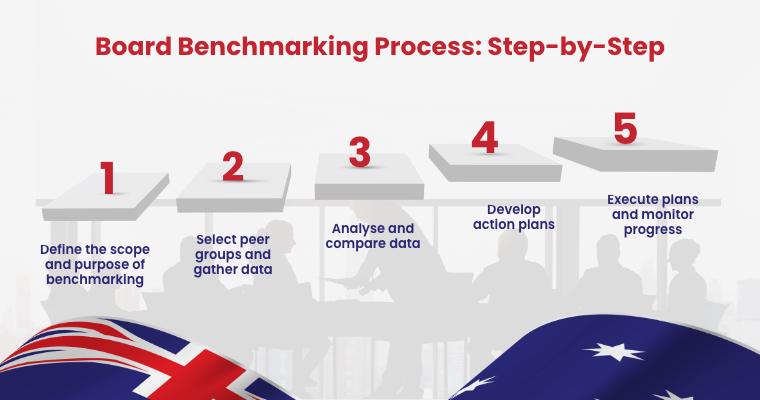Corporate accountability, transparency, and informed decision-making are crucial in board governance — especially for Australian boards. With increasing regulatory requirements and growing stakeholder expectations in the region, boards must continuously assess their effectiveness and adopt best practices to remain compliant and competitive.
In early 2024, the Australian Securities Exchange (ASX) released a consultation draft for the proposed 5th edition of the Corporate Governance Principles. These updates reflect evolving investor and community sentiments on corporate conduct, stakeholder relationships, workforce diversity, material risk management, and executive remuneration.
Notably, recommendations in Principle 2 compel action, emphasising that companies will be required to publish a skills matrix, identify the skills of the current directors, and disclose plans to fill any gaps. Listed entities are also subject to compulsory disclosure of the process of skills and experience assessment of the directors.
Australian boards must therefore regularly evaluate their structure, leadership, and policies to maintain both compliance and competitiveness. Beyond board assessments, board benchmarking is another valuable tool for improving board performance and fostering continuous development.
What is board benchmarking?
Board benchmarking is a systematic process of evaluating and comparing a company’s board performance, structure, and governance practices against industry peers, best practices, and regulatory standards. This data-driven approach applies to organisations of all sizes and sectors, boosting board performance.
While similarly used for evaluation, board assessments and benchmarking differ and complement each other. Board assessments evaluate internal effectiveness, focusing on board performance, directors, and committees to drive internal improvements. Whereas, benchmarking compares the board to peers, revealing strengths and weaknesses against external standards. Together, they provide a 360-degree view of board effectiveness.
Board benchmarking can set the roadmap for improvement and prioritise the changes to enhance overall governance. By assessing themselves against other organisations, Australian boards can ensure better decision-making, stakeholder alignment, and regulatory compliance.
In October 2024, the Institute of Community Directors Australia (ICDA) announced a partnership with a national board assessment service to offer accessible, high-quality benchmarking for not-for-profits. The board effectiveness survey tool assesses 14 board categories mapped against ICDA’s training and resources.
Why does board benchmarking matter for Australian companies?

Examining one’s performance against one’s industry peers offers several advantages, helping them enhance governance, accountability, and effectiveness. Key benefits of board benchmarking include:
Strengthened governance and regulatory compliance
Benchmarking enables organisations to align their board practices with industry standards and regulatory expectations, such as the ASX Corporate Governance Principles. For example, under the proposed 5th edition, companies in the S&P/ASX 300 Index must establish a measurable objective to have a ‘gender-balanced board’ (at least 40% women/at least 40% men/up to 20% any gender). Implementing board benchmarking can help assess current board diversity, comply with the updated principles, and inform director recruitment strategies to meet these new standards.
Optimised board composition and board effectiveness
Assessing board structures against industry peers helps identify areas for improvement, providing an objective, data-driven approach to performance evaluation. This minimises evaluation biases and highlights skill and diversity gaps to support informed board recruitment and succession planning.
Improved decision-making
A systematic approach to board evaluation offers comparative data on industry-leading governance practices. These data-driven insights support boards in making informed decisions about policies, procedures, and management strategies, strengthening governance.
Enhanced reputation and investor confidence
Adhering to best practices can signal to stakeholders a company’s commitment to strong corporate governance. Clearly communicating benchmarking results can build trust, relationships, and confidence among investors and regulators — solidifying corporate reputation and competitive positioning in the market.
What are the key metrics in board benchmarking?
Identifying key performance indicators (KPI) is critical for successful board benchmarking. These metrics allow a comparison of the board’s performance against leading practices and industry peers, highlighting both strengths and areas for improvement.
While board assessments focus internally, similar KPIs can be used for peer comparisons. Essential metrics include:
Board Composition and Skills
Metrics under this category evaluate diversity, independence, tenure, and relevant skill sets to ensure well-rounded management.
- Diversity: Board diversity considers multiple factors, including gender, age, ethnicity, and professional background. Illustrating progress in one key area, the 2024 Board Diversity Index highlights the increasing representation of women on ASX300 boards, rising from 35% in 2023 to 36% in 2024.
- Expertise: Assesses the mix of skills and experience of the board members and how they align with the organisation’s values.
- Independence: Focuses on the proportion of independent directors on the board.
- Board size: No specific number of directors is required to be on the board, but the Corporate Governance Principles suggest a size that can effectively handle decision-making.
Board Meeting Practices
This category examines the board’s accomplishments in terms of meeting frequency, attendance rates, and agenda effectiveness.
- Meeting frequency and duration: Measures how often the board meets and how long the meetings are.
- Agenda management: Examines board management on how meetings are structured and the time allotted for each item.
- Quality of discussions: Determines the level of engagement and contribution from directors during meetings.
- Decision-making process: Measures how effectively the board makes decisions, from agenda, and deliberations to the method of coming up with a decision (e.g. secret ballot voting).
Director Engagement
Board benchmarking involves evaluating how well the board of directors is receptive and partaking in discussions and decisions.
- Attendance rates: A strong attendance rate can indicate high engagement and commitment among members.
- Access to information: This identifies whether directors have timely and accurate access to information relevant to decisions.
- Contribution assessment: The level of active participation that gauges the directors’ impact on meetings and resolutions.
- Director development: What are the opportunities for directors to enhance their skills? How many training sessions do directors undergo annually?
Decision-Making and Oversight
A well-structured board comprises individuals capable of leading the company to success. Directors then should be evaluated on:
- Strategic alignment: How well do the board’s decisions reflect and support the company’s objectives?
- Risk management: How well does the board oversee risk management frameworks and processes? How strong are the risk mitigation strategies?
- Financial oversight: How thorough and effective is the board review and approval process for budget and financial reporting?
- Shareholder engagement: How does the board engage with the stakeholders to build trust and confidence?
- Reporting standards: How is the quality of board reports? Does it reflect the board’s accountability?
Governance Practices
Benchmarking allows the board members to assess how policies and bylaws are effective. Some metrics to consider include:
- Board charter: Evaluates how clear and accurate the charter outlines roles and responsibilities.
- Policies and procedures: Examines the effectiveness of key governance policies and procedures.
- Ethical conduct: Measures the board’s commitment to ethics and compliance with regulations and laws.
- Board evaluation: How frequently and thoroughly does the board conduct self-assessments and third-party board assessments?
Methods of Benchmarking

Understanding performance metrics should not lead to rushed or superficial assessments. While smaller organisations may directly create questionnaires based on predefined metrics, effective and data-driven benchmarking often requires one or a combination of the following methods:
Surveys and Questionnaires
One of the most common assessment tools, surveys and questionnaires provide a structured approach using ratings and questions to evaluate board performance. These can be implemented through:
- Self-assessment: Board members individually complete questionnaires assessing their own performance, the board’s practices, and overall performance. This provides valuable input but can be biased.
- Peer review: Directors fill out board surveys assessing the other director’s performance and contributions.
- Stakeholder feedback: This includes input from senior management, employees, and other stakeholders via feedback surveys or interviews — offering a broader perspective on the board’s effectiveness.
Interviews and Group Discussions
For deeper qualitative insights, interviews and discussions can supplement the quantitative evaluation of performance metrics.
- Individual interviews: A facilitator or consultant conducts in-depth interviews with each director regarding the board’s performance, strengths, weaknesses, challenges, and opportunities.
- Focus group discussions: These sessions involve the directors and/or stakeholders to encourage open dialogue and collective evaluation of board effectiveness.
Data Analysis
Quantitative data can serve as a valuable tool in measuring board effectiveness. Key sources include:
- Skills matrix: Analysing board composition against the required skill set offers insights into the board’s alignment with business strategy.
- Available quantitative data: Metrics such as meeting attendance, committee structure, and decision-making efficiency can identify gaps and opportunities.
External Reviews
Aside from internal data and processes, external evaluations provide objective insights into how the board is performing. These include:
- Peer comparison: Comparing board structures, leadership, and effectiveness against industry peers using financial and operational metrics.
- External independent reviews: Third-party governance experts or consulting firms assess the board’s performance, offering unbiased recommendations.
- Industry best practices: Assessment of governance practices against leading industry frameworks, including ASX principles.
Board Benchmarking Process: Step-by-Step

A well-executed board benchmarking report provides valuable, data-driven insights into your board’s effectiveness, helping you enhance governance and align with industry best practices. Here’s how to create a compelling and actionable benchmarking report:
1. Define the scope and purpose of benchmarking
Start by outlining the purpose, criteria, and scope of your benchmarking. Clearly articulate why you’re undertaking such process. Consider:
- What specific areas of board performance are you looking to assess?
- What are the key performance indicators (KPIs) and metrics that will be used to evaluate the board?
- Which aspects of the board’s work will be included in the benchmarking exercise — full board, specific committees, or individual director performance?
2. Select peer groups and gather data
In identifying your peers, choose organisations that are similar in industry, structure, and complexity as yours. Factors to also consider are the number of comparators and the availability of their data, to ensure you get a meaningful comparison.
Collect data from a variety of resources including self-assessments, board surveys, interviews, organisational documents, and publicly available data. To have a more comprehensive and accurate benchmarking report, incorporate both quantitative and qualitative data collection methods.
3. Analyse and compare data
After gathering all the available data, you should then proceed with analysis which includes comparing against peers, identifying trends, and identifying gaps. Through this, you’ll be able to pinpoint areas where your board is excelling as well as areas where it lags behind its peers. This also provides a clear, evidence-based view of how your board measures up in governance, leadership, and overall effectiveness.
4. Develop action plans
Insights without action lead nowhere. Use benchmarking findings to craft a strategic improvement plan by:
- Prioritising key areas for development
- Implementing best practices from high-performing peers
- Assigning responsibilities to address identified gaps
The goal is not just to assess performance but to actively drive meaningful improvements.
5. Execute plans and monitor progress
Put your plan into action and ensure stakeholders are aligned with the changes. Track the progress and assess the impact of the changes on the board’s effectiveness and organisational performance. For continuous improvement, conduct board benchmarking regularly and review your comparator organisations.
Overcoming the Challenges in Board Benchmarking
Board benchmarking, while a valuable tool for performance improvement, comes with its own set of hurdles, including:
Limited data availability and comparability
Sometimes, it can be difficult to find peers that are truly comparable in size, industry, and complexity. Additionally, publicly available data is often scarce, outdated, or inconsistent.
How to address: Seek help from governance experts or third-party firms to find alternative methods to gain data. Leverage multiple assessment methods to fill data gaps.
Subjectivity and bias
When benchmarking is overreliant on self-assessments, biases can result in inconsistent and unreliable data, leading to an inaccurate reflection of board performance.
How to address: Minimise bias by employing a multi-faceted approach — incorporating multiple benchmarking methods. A diverse set of perspectives provides a more balanced and reliable analysis.
Confidentiality and sensitivity
Benchmarking often involves sharing and handling sensitive board information, which can create transparency and trust concerns in the process.
How to address: Establish clear objectives from the outset and communicate how the data will be used. Engage board members to ensure the process is about improvement, not exposure.
Resistance to change
Not all board members may welcome benchmarking results — especially if they highlight significant areas for improvement. Resistance often stems from a fear of criticism or disruption to established processes.
How to address: Position benchmarking as a tool for growth rather than a critique. Emphasise its role in driving strategic improvements, enhancing governance, and ensuring long-term success.
Strategic Boards, Stronger Organisations with Convene

Great boards embrace feedback, adapt to change, and continuously strive for excellence. Benchmarking is a powerful way to assess board effectiveness, but without a structured workflow, the process can become complex and inefficient. Thankfully, Convene supports all your board activities.
As a trusted board management software for Australian organisations, Convene simplifies board governance and enhances meeting efficiency. Tailored for the corporate, public sector, university, healthcare, and not-for-profit boards, Convene empowers strategic decision-making with features such as:
- Seamless meeting management: Collaborate with board directors and stakeholders via videoconferencing, real-time annotation tools, and presentation tools.
- Document collaboration: Securely review, approve, and sign board documents with dedicated review rooms and digital signatures.
- Board surveys and polls: Conduct board assessments, board effectiveness surveys, and quick polls for data-driven decisions.
- Advanced security measures: Protect sensitive board data and documents with multi-factor authentication, password encryption, and strict access controls.
Drive efficiency and organisational success with Convene. Schedule a free product demo today to see how the board management software can help you with better board governance.
Audrey is a Content Marketing Specialist at Convene, in charge of managing the production of quality content on the company’s website. A communication major keen on marketing, Audrey has been constantly seeking approaches to create tailored content—may it be about governance, digitalization, boards, or meetings—fit for the stakeholders. When not strategizing on the next ebook to produce, Audrey finds solitude in reading make-you-ugly-cry novels and listening to self-improvement podcasts.




